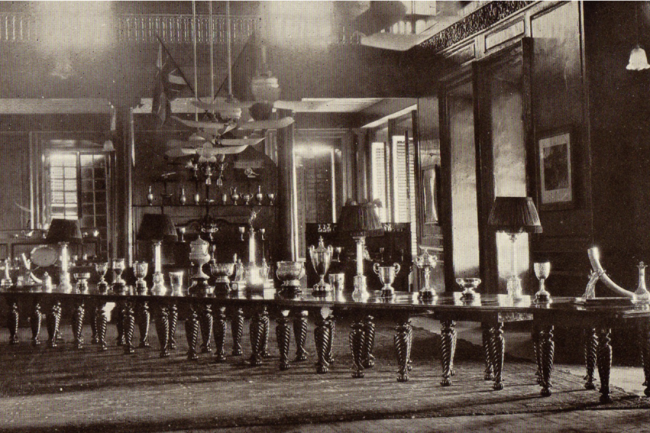
Mess plate of 1st Battalion The Leinster Regiment displayed on the Jhansi table (photographed in Madras in 1922 shortly before the battalion returned to the United Kingdom for disbandment)
The Jhansi table (formerly the property of the Rajas of Jhansi) came into the possession of the 3rd Bombay European Regiment (subsequently the 109th Foot) during the suppression of the Indian Mutiny in 1858.
Custody of the table passed from the 109th Foot (2nd Battalion The Leinster Regiment from 1881) to the 100th Foot (linked with the 109th Foot under the Cardwell reforms; 1st Battalion The Leinster Regiment from 1881) in 1877.
On the disbandment of The Leinster Regiment in 1922, the table was handed over to the Army Council for safe keeping. Silver plaques commemorating the transfer to the custody of the Army Council were inserted at both ends of the table in 1940.
The Army Council was dissolved in 1964 and in 1973 the table passed into the custody of the National Army Museum (most of it being installed in the Reading Room and some components being held in store).
The Royal Asiatic Society acquired the table in 2007. The Society had relocated to 14 Stephenson Way, London in February 2007 and was anxious to acquire an appropriate table for its Council Room. The relocation of the Royal Asiatic Society coincided with the adoption of a plan to reorganize the reading facilities at the National Army Museum; this plan made the table surplus to the Museum’s requirements.
A detailed historical account of the table is at pages 23-25 of Military and Naval Silver: Treasures of the Mess and Wardroom by Roger Perkins (published privately by the author in 1999). A shorter account by Captain F C Hitchcock MC (probably written in the 1960s) seems to have passed to the Royal Asiatic Society with the table; this account was published in the Society’s journal in 2007.
Both Perkins and Hitchcock make confusing references to the numbers of leaves and legs comprising the table. 2009 correspondence with the Royal Asiatic Society reveals that the complete table comprises nine main leaves (each with four associated legs; ie the total of legs is 36) plus 13 small leaves of various sizes (with no associated legs). The table as erected in the Society’s Council Room comprises seven main leaves (with 28 associated legs) and eleven small leaves; two main leaves, two small leaves and eight legs are displayed or stored elsewhere in the building
